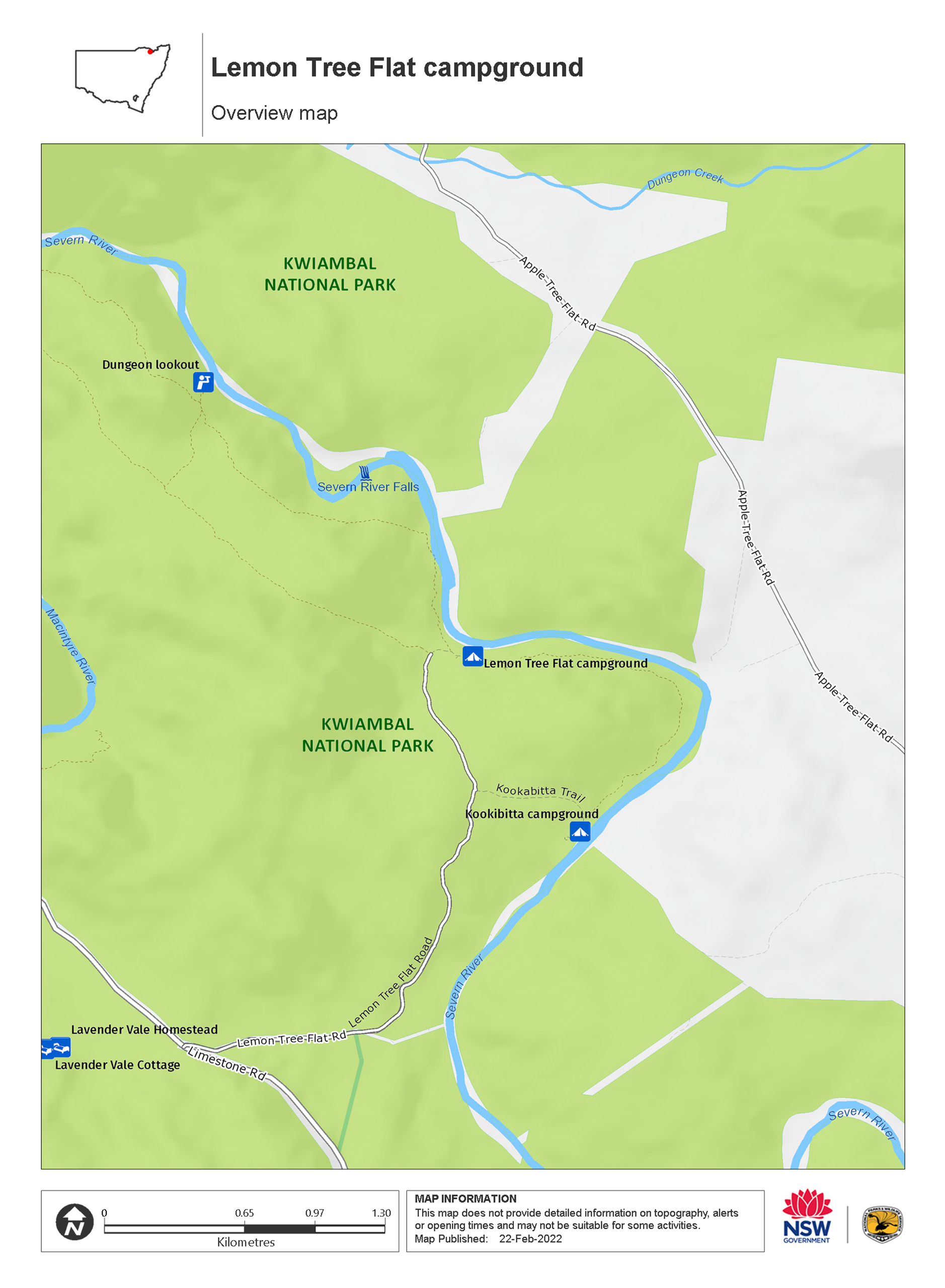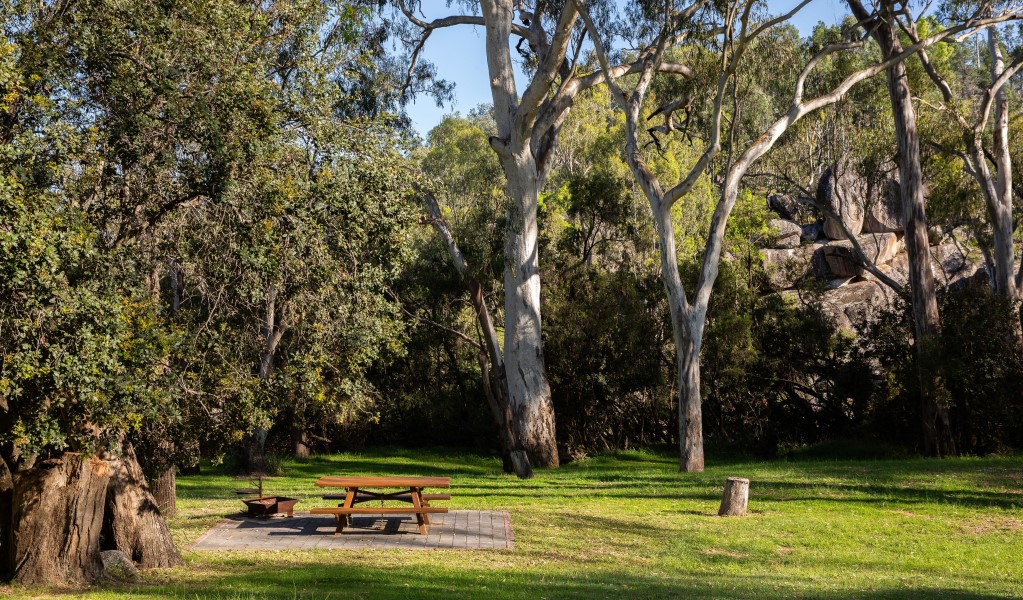Lemon Tree Flat campground
Kwiambal National Park
Overview
Lemon Tree Flat campground offers Kwiambal’s best camping, with barbecues and picnic spots for day trippers, hiking tracks for adventurers, and swimming for everyone.
| Number of campsites | 10 |
|---|---|
| Camping type | Tent, Camper trailer site, Caravan site, Camping beside my vehicle |
| Facilities | Picnic tables, barbecue facilities, carpark, drinking water, toilets |
| Group bookings | Book up to 20 people or 5 sites online. For larger groups, make a group booking enquiry. |
| Please note |
|
Positioned on a large grassed area alongside Severn River, Lemon Tree Flat campground is a great place to base yourself while you uncover the remote attractions of Kwiambal National Park. There are plenty of tables and wood barbecues – pack a picnic for a leisurely lunch or bring a tent for a weekend getaway to truly appreciate the cypress pine woodlands and abundant wildlife.
Within easy walking distance of the campground are fishing, swimming and hiking opportunities, along with plenty of chances to entertain a little birdwatching – you might even spot a wedge-tailed eagle circling above your camping spot. If privacy is what you’re after, bring some hiking boots and follow Junction walk, a four-kilometre trail from the campground which takes you to the junction of Severn and Macintyre rivers. Several small, secluded beaches are tucked between the rocks, with calm water ideal for a refreshing dip.
Lemon Tree Flat offers tank water suitable for drinking after treatment, though it’s also a good idea to bring your own as well.
Map

Map legend

Local alerts
For the latest updates on fires, closures and other alerts in this area, see https://www.nationalparks.nsw.gov.au/camping-and-accommodation/campgrounds/lemon-tree-flat-campground/local-alerts
Bookings
- National Parks Contact Centre
- 7am to 7pm daily
- 1300 072 757 (13000 PARKS) for the cost of a local call within Australia excluding mobiles
- parks.info@environment.nsw.gov.au
Operated by
- Glen Innes office
- Monday to Friday, 8.30am to 4.30pm.
- 02 6739 0700
- npws.ntab@environment.nsw.gov.au
- 68 Church Street, Glen Innes NSW 2370
Park info
- in Kwiambal National Park in the Country NSW region
Kwiambal National Park is always open but may have to close at times due to poor weather or fire danger.
Visitor info
All the practical information you need to know about Lemon Tree Flat campground.
Maps and downloads
Learn more
Lemon Tree Flat campground is in Kwiambal National Park. Here are just some of the reasons why this park is special:
Aboriginal cultural heritage

Kwiambal takes its name from the aboriginal people of the Ashford district. Rich in food, water and materials, the area provided a year-round living environment for their ancestors, with sacred sites and hunting grounds spread throughout the park.
Animals

There are five rare or threatened plant species in the park: severn wattle, Rodd’s star hair, caustic vine, daisy bush and toadflax. Feel free to look, but please be careful not to damage the plants. In the warmer months of September to March, the wildflowers bloom throughout the bush. Like its flowers, Kwiambal is home to dozens of notable animal species, including 32 types of reptile, 11 frogs, and 30 species of mammal. Some 18 species are threatened or endangered, including koalas, squirrel gliders, and five-clawed worm skinks. There are also an astonishing 101 types of bird, making the park a hot spot for avid birders. Keep an eye out for painted honeyeaters, barking owls, hooded robins, and diamond firetails.
- Dungeon lookout Where Severn River enters a steep gorge, you’ll find The Dungeon, with this lookout offering superb views down into the swell, particularly after rain.
- Macintyre Falls lookout Adjacent to a well-equipped picnic area, Macintyre Falls lookout offers scenic views over the river, with nearby swimming, hiking and fishing opportunities.
- Slippery Rock walking track Slippery Rock walking track in Kwiambal National Park, near Inverell, offers spectacular gorge views as well as fishing, birdwatching and vibrant wildflowers in spring.
Historic heritage

The flat areas of the park have been subjected to farming of tobacco, giving way to cereal crops and the mining of various minerals and sapphires. Unsurprisingly then, there are a number of historical landmarks within the park, including tobacco-drying sheds, woolsheds, fruit trees, storage sheds, and the remains of a house. History enthusiasts will want to seek these out on a visit.
Native rainforest

Kwiambal contains 15 per cent of the native dry rainforest left in NSW. The vegetation is dominated by white cypress pines, silver-leaved ironbarks, and tumbledown gums. Unfortunately, much of the planning area has been subjected to logging in the past, though considerable regeneration makes it a worthy destination for nature-lovers.
- Dungeon lookout Where Severn River enters a steep gorge, you’ll find The Dungeon, with this lookout offering superb views down into the swell, particularly after rain.
- Junction walk Junction walk offers a stroll through ironbarks and pine trees to the meeting of Severn and Macintyre rivers, with swimming, picnicking, and birdwatching opportunities.
- Macintyre Falls lookout Adjacent to a well-equipped picnic area, Macintyre Falls lookout offers scenic views over the river, with nearby swimming, hiking and fishing opportunities.
- Slippery Rock walking track Slippery Rock walking track in Kwiambal National Park, near Inverell, offers spectacular gorge views as well as fishing, birdwatching and vibrant wildflowers in spring.

